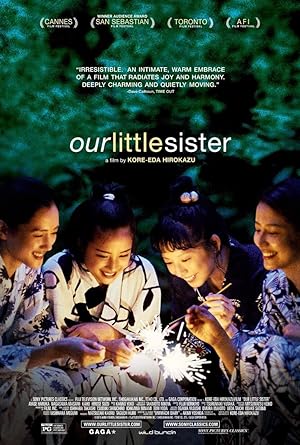If you get a chance to see a film by Hirokazu Koreeda, I don’t care what his movie is about, see it. I have never been disappointed by one of his films, and I want to see all his films, which is difficult because not all of them are available in the US. As soon as Our Little Sister, which was in theaters in 2015, became available on DVD in the US, I snagged it and watched it.
Our Little Sister is an elegiac film devoted to the joys of living. Three adult sisters live in their maternal grandparents’ home and hear that their estranged father has died. Without acrimony, it is not a given that they will attend the funeral, but life has a way of making things work, and they meet their half-sister, whom they invite to live with them. Our Little Sister focuses on their life together as they gradually transform as human beings do.
Our Little Sister is amazing because film rarely captures how time gradually passes and people change without falling into melodramatic traps. Our Little Sister exists in a real world where much has transpired before these characters existed and will continue long after the movie ends. Koreeda places us in a world where death is a given, not innately a tragedy, just an end although there may be a subtle nod to impending ecological disaster as signaled by incremental changes in daily life. The plum tree produces less fruit. Whitefish is no longer widely available. There is also death in relationships. The titular character is always painfully aware that even though her sisters love her, the seed of her existence has roots in sororal sorrows. The joy and pain of life is inextricably intermingled.
Our Little Sister depicts each sister in subtle and understated ways that make them feel like fully formed human beings, which also points to the expertise and excellence of the ensemble cast. The oldest sister is a medical professional who decides on a career change that signals a steady inner strength that surprises her. She plays mother to her sisters. She relates most to the titular character because she sees herself in her little sister and wants to rescue her from the irresponsible adults who rely on her. When the nature of the oldest sister’s personal relationship is revealed, it is shocking, but not surprising that she is repeating her family’s mistakes and working out her issues with her parents.
The second sister is finally achieving professional success, but giddy joy over the accoutrements and privileges of finance give way to the real world gravity of how her job changes the lives of ordinary people. She unconsciously follows in the oldest sister’s footsteps as another type of caretaker to her community.
The third sister gets less focus than the others. She seems to take a grunge, alternative approach to life, but I suspect that a second viewing would reveal the nuances of her character.
When I saw Our Little Sister, I thought that it was the perfect movie to see before Gilmore Girls: A Year In The Life, but now after seeing the Netflix series, Our Little Sister shows me how far Americans have to go to in creating a textured, complete portrait of daily family life without the histrionics. Subtitles are a small price to pay for the perfection of Our Little Sister.
Stay In The Know
Join my mailing list to get updates about recent reviews, upcoming speaking engagements, and film news.





